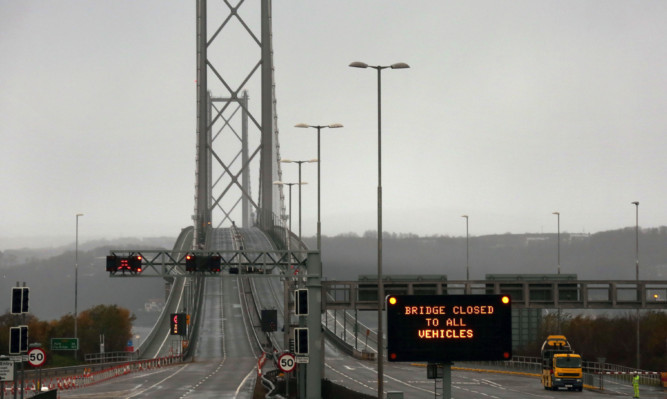The fault which led to the closure of the Forth Road Bridge could only have been detected if hi-tech structural monitoring had been in place, MSPs have been told.
An independent engineering consultant told Holyrood’s Infrastructure Committee that a seized pin had caused the crack which led to the shutdown of the bridge for almost three weeks in December.
Richard Hornby, of engineering consulting firm Arup, said there were no displayed signs of distress and nothing in the inspection regime for the bridge which would have determined the fault.
The pin could have been seized for a number of years and only lasted so long because of the quality of the steel, Mr Hornby said.
He agreed with John Russell, operations manager for bridge operator Amey, who said only structural health monitoring could have “perhaps picked it up sooner”.
The committee has begun its inquiry into the bridge closure, which began on December 4. It was reopened to all traffic except HGVs on December 23.
MSPs were told it is estimated HGVs will be allowed back on to the bridge in mid-February.
Mr Hornby said: “The failure of the member was because the pin had seized, and probably had seized for a number of years. It’s only because the steel has been so good that it has lasted so long.”
He said there were “no displayed signs of distress in this element”.
“There was no evidence that these pins were not moving from the inspections that were carried out,” he said.
Mr Hornby said bridge operators would have had to have structural health monitoring to detect the problem, “otherwise you are inspecting at a six-monthly basis to check there is not a crack”.
Mr Russell told the committee that, since 2001, the failed section was inspected 23 times and there was no fault found.
“In the current circumstances and technology that we have on the Forth Road Bridge, that wouldn’t have been able to have been foreseen,” he said.
“My opinion would be if we have structural health monitoring on the bridge, that would be the way forward. If we had had that, it perhaps may have been picked up – perhaps.”
The committee heard the latest monitoring will be used on the new Queensferry Crossing and is in place on some sections of the Forth Road Bridge, but installing it on the entire structure would cost millions.
MSPs were also told by several witnesses a decision by previous bridge operator Forth Estuary Transport Authority (Feta) not to proceed with a £15 million truss end link replacement project in 2010 had been “reasonable” and “proportionate”.
The issue being addressed in this project was “unrelated to the unexpected defect which closed the bridge”, Scott Lees, head of network maintenance at Transport Scotland, said.
